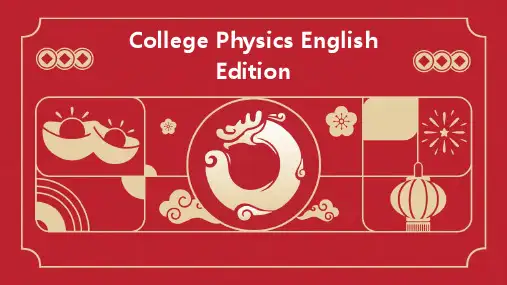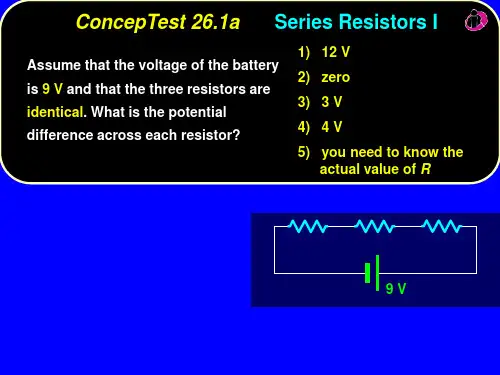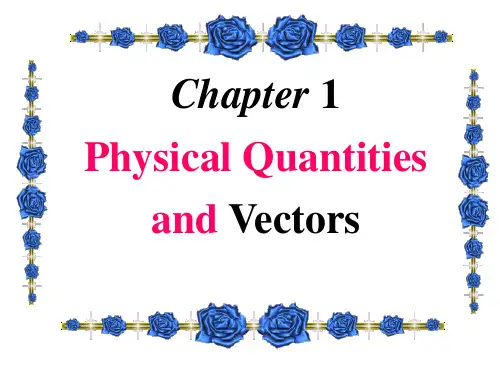西尔斯当代大学物理双语PPT课件
- 格式:ppt
- 大小:285.50 KB
- 文档页数:22
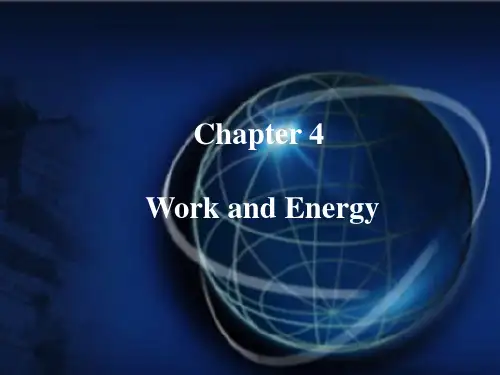
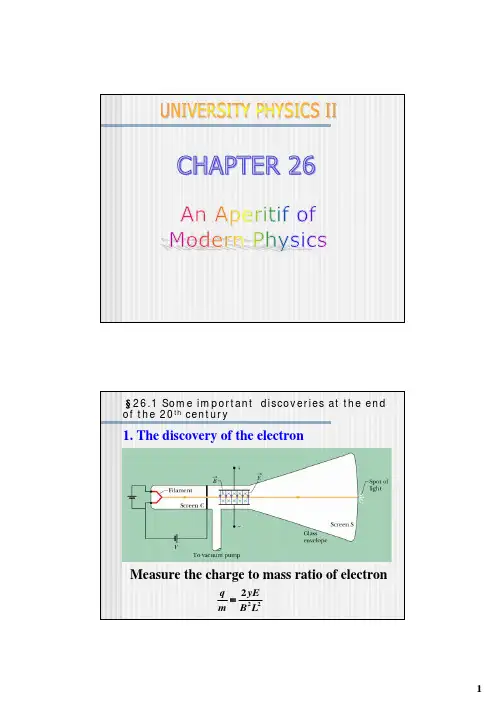
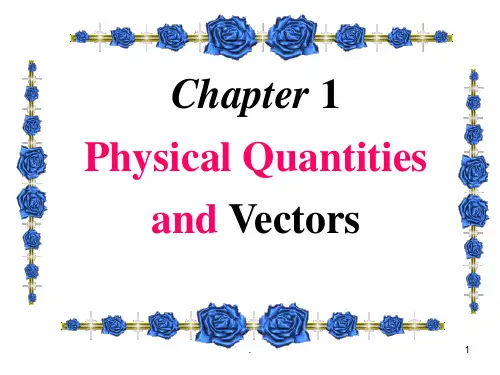
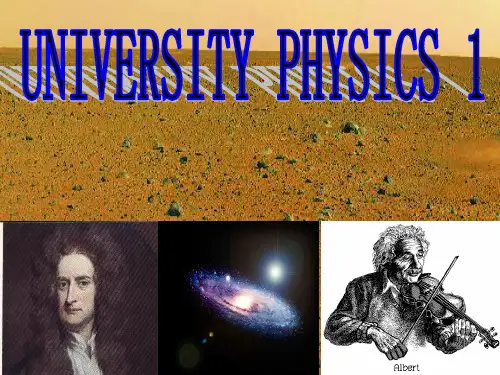
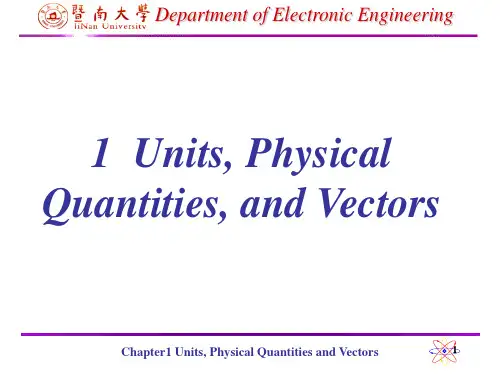
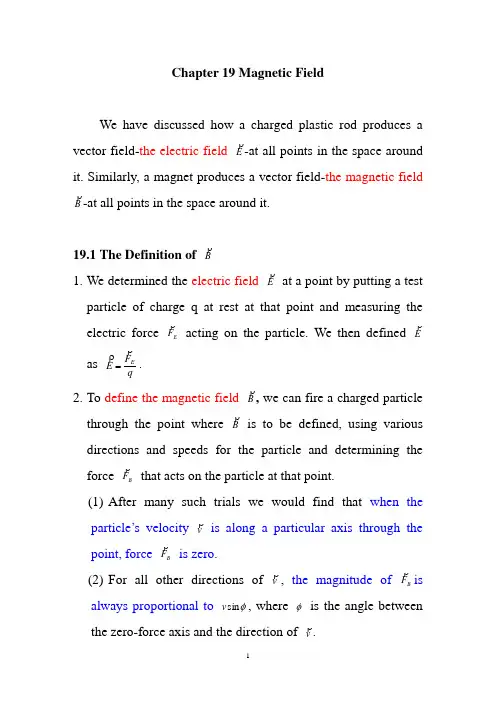
Chapter 19 Magnetic FieldWe have discussed how a charged plastic rod produces a vector field-the electric field E -at all points in the space around it. Similarly, a magnet produces a vector field-the magnetic field B -at all points in the space around it.19.1 The Definition of B1. We determined the electric fieldE at a point by putting a test particle of charge q at rest at that point and measuring the electric forceE F acting on the particle. We then defined E as q F E E =.2. To define the magnetic fieldB , we can fire a charged particle through the point whereB is to be defined, using various directions and speeds for the particle and determining the force B F that acts on the particle at that point.(1) After many such trials we would find that when theparticle ’s velocity v is along a particular axis through thepoint, force B F is zero .(2) For all other directions ofv , the magnitude of B F is always proportional to φsin v , where φ is the angle betweenthe zero-force axis and the direction of v .(3) Furthermore, the direction B F is always perpendicular tothe direction of v (These results suggest that a cross productis involved).3. We can then define a magnetic fieldB to be a vector quantity that is directed along the zero-force axis . We can next measure the magnitude of B F when v is directed perpendicular tothat axis and then define the magnitude ofB in terms of that force magnitude: vq F B B =, where q is the charge of the particle. 4. We can summarize all these results with the following vector equation: B v q F B ⨯=.5. Finding the magnetic force on a particle: The forceB F acting on a charged particle moving with velocityv through a magnetic field B is always perpendicular tov and B . 6. The SI unit for B is the netown per coulomb-meter persecond. For convenience, that is called the tesla (T). An earlier (non-SI) unit for B , still in common use, is the gauss (G), and 1 tesla = 104 gauss.7. Right table lists themagnetic fields thatoccur in a fewsituations.8. We can represent magnetic fields with field lines , just as wedid for electric field. Similar rules apply. That is, (1) the direction of the tangent to a magnetic field line at any point gives the direction B at that point, and (2) the spacing of the lines represents the magnitude of B -the magnetic field is stronger where the lines are closer together, and conversely. 9.Figures show the magnetic field lines for magnet with different shapes. We find that the lines all pass through the magnet, and they form closed loops(even those that are notshown closed in the figures). The closed field lines enter one end of a magnet and exit the other end. The end of a magnet from which the field lines emerge is called the north pole of the magnet; the other end, where field lines enter the magnet, is called the south pole.10.W hen two magnets are moved to each other, we find that opposite magnetic pole attract each other, and like magnetic pole repel each other.11.E arth has a magnetic field that is produced in its core by stillunknown mechanisms.19.2 Crossed FieldBoth an electric field E and a magnetic field B can produce a force on a charged particle. When the two fields are perpendicular to each other, they are said to be crossed fields. 1.Discovery of the electron: Figure shows a modern version of J.J. Thomson’s apparatus for measuring the ratio of mass to charge for the electron.2.The Hall effect: Halleffect allows us to findout whether the chargecarriers in a conductoror semiconductor arepositively ornegatively charged.Beyond that, we can measure the number of such carriers perunit volume.(1) Figure shows a strip of copper carrying a current i is immersed in a magnetic field.(2) A hall potential difference is the difference of the electric filed potential between to edges of the strip. The magnitude of that potential difference is Ed V =.(3) When the electric and magnetic force are in balance , we have B ev eE d =, in which the drift speed of electrons is neA i v d =, in which n is the number density of charge carries.(4) From above three equations, we haveVleBi n =, in which l (=A/d) is the thickness of the strip.19.3 A Circulating Charged Particle1. If a particle moves in a circle at constant speed, we can be sure that the net force acting on the particle is constant in magnitude and points toward the center of the circle, always perpendicular to the particle ’svelocity.2. Figure shows that a beam ofelectrons is projected into achamber by an electron gun G .The electrons enter in theplane of the page with velocity v and move in a region ofuniform magnetic field B directed out of the plane of thefigure. As a result, a magnetic force continually deflects the electrons, and because v and B are perpendicular to eachother, this deflection causes the electrons to follow a circular path.3. From Newton ’s law applied to uniform circular motion, we have rmv qvB 2=. (1) So the radius of the circular path is qBmv r =. (2) The period (the time for one full revolution) is equal to the circumferencedivided by the speed:qBm v r T ππ22==. (3) The frequency is mqB T f π21==. (4) The angular frequency of themotion is then mqB f ==πω2. (5) They are do not dependon the speed of the particle.4. Helical paths : If the velocityof a charged particle has acomponent parallel to the (uniform) magnetic field , theparticle will move in helical path about the direction of the field vector, as shown in figure (a) and (b). The parallel component of the velocity determines the pitch of the helix, that is, the distance between adjacent turn. The perpendicular component determines the radius of the helix.5.Figure (c) shows the charged particle spiraling in a non-uniform magnetic field. The more closely spaced field lines at the left and right sides indicate that the magnetic field is stronger there. When the field at end is strong enough, the particle “reflects”from that end. If the particle reflects from both ends, it is said to be trapped in a magnetic bottle. Electrons and protons are trapped in this way by the terrestrial magnetic field, forming the Van Alen radiation belts, which loop well above Earth’s atmosphere, between Earth’s north and south geomagnetic poles. The trapped particles bounce back and forth, from end to end of the magnetic bottle, within a few seconds.19.4 Cyclotrons and Synchrotrons1.The Cyclotron is a device forgiving high speed to chargedparticles by magnetic and electricfields. See the figure.2. The proton synchrotron:19.5 Magnetic Force on a Current-Carrying Wire1. See right figure, in which thecurrent-carrying wire is perpendicular tothe magnetic field, the magnetic force isiLB F B =.2. If the magnetic is not perpendicular tothe wire, as in right figure, themagnetic force is given byB L i F B ⨯=. Here L is a lengthvector that points along the wiresegment in the direction of the conventional current.3. If a wire is not straight , we can imagine it broken up into small straight segments and apply above equation to each segment. The force on the wire as a whole is then the vector sum of all the force on the segments that make it up. In the differential limit, we can write B L id F d B ⨯=, and we can find the resultant force on any given arrangement of currents by integrating it over that arrangement .19.6 Torque on a Current Loop and the Magnetic dipole1. Figure shows a simplemotor, consisting of asingle current-carryingloop immersed in a magnetic field B .2. The magnitude of the torque is θθτsin )(sin B iA iabB ==.3. We can describe the current-carrying coil with a single vector μ , its magnetic dipole moment , we take the direction of μ tobe that of the normal vector n to the plane of the coil, asfigure (c). We define the magnitude ofμ as NiA =μ, in which N is the loop of the coil; A is the area enclosed by the coil. Then the torque can be written as B⨯=μτ 4. While an external magnetic field is exerting a torque on a magnetic dipole, work must be done to change the orientation of the dipole. The magnetic dipole must then have a magneticpotential energy . We can write it as B U ⋅-=μθ)(.。
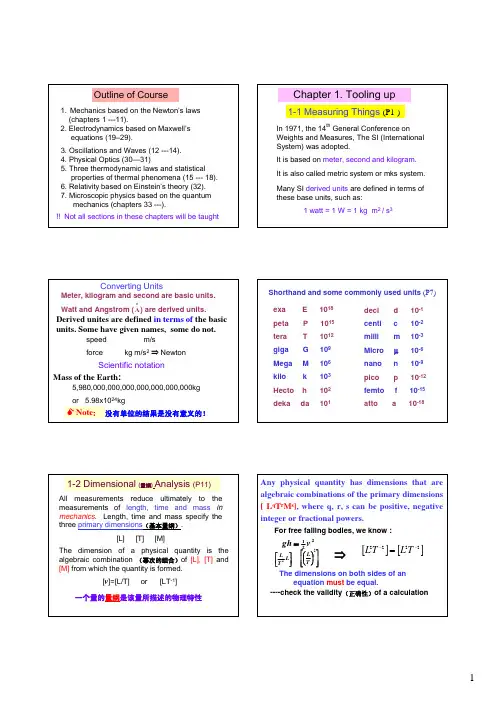
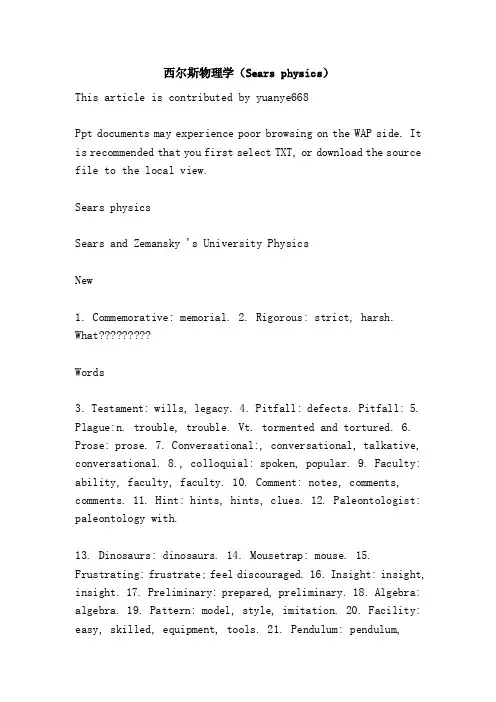
西尔斯物理学(Sears physics)This article is contributed by yuanye668Ppt documents may experience poor browsing on the WAP side. It is recommended that you first select TXT, or download the source file to the local view.Sears physicsSears and Zemansky 's University PhysicsNew1. Commemorative: memorial.2. Rigorous: strict, harsh. WhatWords3. Testament: wills, legacy.4. Pitfall: defects. Pitfall:5. Plague:n. trouble, trouble. Vt. tormented and tortured.6. Prose: prose.7. Conversational:, conversational, talkative, conversational.8., colloquial: spoken, popular.9. Faculty: ability, faculty, faculty. 10. Comment: notes, comments, comments. 11. Hint: hints, hints, clues. 12. Paleontologist: paleontology with.13. Dinosaurs: dinosaurs. 14. Mousetrap: mouse. 15. Frustrating: frustrate; feel discouraged. 16. Insight: insight, insight. 17. Preliminary: prepared, preliminary. 18. Algebra: algebra. 19. Pattern: model, style, imitation. 20. Facility: easy, skilled, equipment, tools. 21. Pendulum: pendulum,pendulum bob. 22. Chandelier: tree shaped decorative lamp. 23. Cathedral: cathedral. 24. Ultraviolet: UV radiation. 25. Infrared: infrared. 26. Jupiter: jupiter. 27., Interplay: interact with each other. 28. Inconsistent: inconsistent; contradictory. 29. Cannonball: shells. 30., Validity: validity, validity, correctness.31. Strategy: strategy, strategy. 32. Absolutely:, complete, absolute. 33. Replica: copies. 34. Spherical: ball type 35. Thereof: in which, relating to... Put it, it's. 36. seam: wiring, suture, scar, layer. 37. Concentrate: concentrates, concentrates. 38., Fairly:, fairly, fairly, clearly. 39. Ruler: ruler. 40., Multiple:, multiple, multiple, multiple, several. Multiplied. 41. Gram: grams. 42. Exponential: index, advocates, index, exponential. 43. Prefix: prefix. 44. Abbreviated: short, abbreviated. 45. Nanometer: nm. 46. Nanosecond: ns. 47. Equivalent: quite. Equal. 48. "Denote:" indicating. 49. in Dimensionally: space, in magnitude, in magnitude. 50. Treated: treated as discussed.51., Multiplication: multiplication, increase, value-added.52. Division: division, division, allocation. 53. Glossary: terms. 54. Thumb: flip the page. 55. Cram: fill up. 56. Equator: equator. 57. Cumbersome: annoying, troublesome, bulky. 58. Porsche Porsche. 59. Cesium: cesium. 60. Bombard: excitation. Sixty-oneGlow: glow, heat. 62. Vacuum: vacuum. 63. Cylinder: cylinder.64. Platinum: platinum, platinum. 65. Iridium: iridium. 66. Alloy: alloy. 67. Prefix: prefix. 68., Consistency: combination, unity, consistency, consistency. Density.69., Conversion: conversion, conversion. 70. Dimensionally: in size or size. 71. "Denote:" indicating. 72. Figures: shape, body shape. Silhouette. Graphics, numbers. 73. Caliper: calipers, calipers, calipers, horns. 74. Error: error. 75. Fractional part of the shard. 76. Scalar. scalar. 77. Vector. vector. 78. Displacement. displacement. 79. Boldface. bold, boldface. 80. Italic. italic. 81. Segment. segments. 82. Magnitude. modulus.83. Anti-parallel. antiparallel. 84. Perpendicular.adj vertical, orthogonal. N perpendicular. 85. Root: n root; root mean square. 86., Mutually:, adv, help each other. 87. Drag: tardiness. 88. Racer: the match.89. Dragster: high speed racing car. 90. Interval: interval, distance, time interval. 91. Precisely: just right. 92. Instantaneous: instant, instant. 93. Instant: immediately; urgent. 94. Calculus: calculus. 95. Approaches: approach; approach. Derivation of 96. Derivative:; derivation. 97. Term: term; terminology. 98. Interchangeably: can alternate. 99. Distinct: clear and clear. 100. "Denote:" indicating.101.Cheetah: India leopard; 102. Crouch: curled, crouch. 103. Ambush: ambush. 104. Blind: blind or blind; disoriented. 105. Antelope: antelopes. 106. Slope: slope; slope. 107. Procedure: procedures; procedures. 108. Race: race; race. 109. Straightaway: straight track; straight line segment.110. Grand Prix: International Grand prix. 111. Catapult: aircraft catapult slingshot. 112. Versus: pairs, relative. 113. Arbitrary: arbitrary. 114. Signpost: roadmap. 115. Wustang: mustang. 116., Approach:, n approach, approach, approach, step, approach. Vt. approach. 117. Concave: adj: concave, concave.N: concave. 118. Label: n. tags, labels, signs. Vt. affixed to, refers to... For, classify. 119. Roller: n roller. 120. Coaster: offshore trade freighter. 121. Radial: adj, radial, ray, radius. Light ray. 122., Wrap, up:, V, disguise, disguise, concentrate, wrap, scarf, wrap up. 123., Neat:, adj., neat, smart, elegant, (wine), pure, not watered. 124. Net: n. network, network, net profit, net. Adj. net, pure. One hundred and twenty-fiveModification: no 更改, 修正. 126. Rope: no 绳索. 127. Tie: no 带子, 领带.vt. 系, 打结. 128. Exert: vt.尽力, 施加, 努力. v.发挥, 竭尽全力, 尽.129. Superposition: no 重叠, 重合, 叠合.合成. 130. Utmost: no 极限, 最大可能, 极力.adj. 极度的, 最远的. 131. Puck: no 恶作剧的小妖精; 冰球. 132. Sustain: 维持, 持续. 133. Ketchup: 调味番茄汁. 134. Contact force: 触点压力 135. Calibrate: v.校准. 136. Platinum: n.白金, 铂. 137. Iridium: no 铱. 138. Dimensionally: adv.尺寸上的.量纲. 139. Handled: adj.把手的.手柄的. 140. Pose: n.姿势, 姿态.v. (使) 摆好姿势, 形成, 因其, 造成. 141. Equilibrium: n.平衡, 平静. 142. Trivia: adj; 琐细的, 价值不高, 微不足道的. 143. Furthermore, adv.此外, 而且. 144. The cutting blade: 切割刀具. 145. Aligned: vi.排列.vt.使结盟, 使成一行. 146. Toboggan: n.平底雪橇.v. 乘撬滑下, 急剧滑下. 147. Iceboat: n.冰上滑行船, 碎冰船. 148. Analytical: adj: 分析的, 解析的.149. Hoisting: n.起重, 提升. 150.synonym: n.同义词.151.normal force: 法向力. 152.slippery: adj. 滑的, 光滑的. 153. Quotient: n.商, 份额. 154. Stick: n.棍, 棒, 手杖.v. 粘住, 粘贴.vt.刺, 戳. 155.horrible: adj.可怕的, 恐怖的, 讨厌的. 156.squeak: n.尖叫声, 吱吱声, 机会.v.发出尖叫声. 157.chalk:n.粉笔. 158.windshield-wiper: 风挡刮雨器. 159.weld: vt.焊接.焊接, 焊缝. 160.toss: v.投掷. 161.drag: v.拖, 拖曳, 缓慢而费力地行动.n.拖拉. 162. Buoyancy: no 浮力, 浮性, 轻快. 163. Terminal: n.终点, 终端.adj. 期末, 末端的. 164. Subatomic: adj.小于原子的; 亚原子的, 次原子的. 165. Unaided: adj. 未受协助的, 独立的 166. Comb: no 梳子, 鸡冠, 蜂巢.vi.梳发, 搜索. 167. Fluff: n.软毛.柔毛, 绒毛, 错误, 无价值的东西.vi. 起毛的. 168. Repulsion: n.推斥, 排斥, 严拒, 厌恶, 反驳.169. Counteract: vt.抵消, 中和, 阻碍. 170. Vital: adj.生死攸关的, 重大的, 生命的, 生机的, 至关重要的. 171. Radioactivity; n.放射能. 172. Beta decay: no β衰变. 173. Antineutrino: n.反中微子. 174. Tremendous: adj. 极大的. 175. Concentration: n.集中, 集合, 专心, 浓缩, 浓度. 176. Stall: no 货摊Corral, stables; V. (to) stop, stop, delay (make). 177. Theorem: theory, theorem. 178. Throttle: kills the brakes. 179. Brake:n. brake. V. brake. 180., Segment:, N. segment, section, fragment. V. segmentation. 181. Rectangle: n. rectangle, rectangle. 182. Elongation: n. extension. 183., Floppy:, adj., soft, lazy. 184. Toy: n. toys. 185., Slinky:, adj., furtive, figure, curve. 186., Stiffer:, adj., stiff, stiff, stiff. 187. Suspension: n. suspension, suspension, suspension, suspension, suspension, 188., Triangle:, N., triangle, three person group.189. Individual: n. individuals, individuals. Adj. individual, individual, individual. 190., Infinitesimal:, adj., infinitesimal, infinitesimal, infinitesimal, N., infinitesimal, infinitesimal. 191., Rigorously:, adj., stern, cruel. 192., Evaluate:, vt., evaluation, valuation, etc... Value; V. evaluation. 193. Obnoxious: adj. unpleasant orunpleasant. 194., Swing:, v., rocking, swinging, turning, spinning; n. swings, swings, swings. 195., Quotient:, N. quotient, share. 196., Deposit:, N. deposits, deposits, deposits, deposits, deposits, vt. deposits, deposits; VI. deposits. 197. Hammerhead: n. adj. hammer; hammerhead, hebetic. 198., Momentarily:, adv., right now. 199., Slant:, v., oblique, oblique; n. inclined. 200. Elongation: n. extension. 201., Coil:, v., coil, roll. 202. Bounce: v. n. jump, jump, bounce back. 203., Suspension:, N. suspension, suspension, suspension, suspension, delay. 204. Flex: vt. bending, stretching, bending; n. VI bending, bending, wire, elastic band. 205. Strategy: n. policy. 206. Wrinkle: n. wrinkles; V. wrinkles.More resources, First day, English first day, math first, politics first, history first, geography firstOne。
